
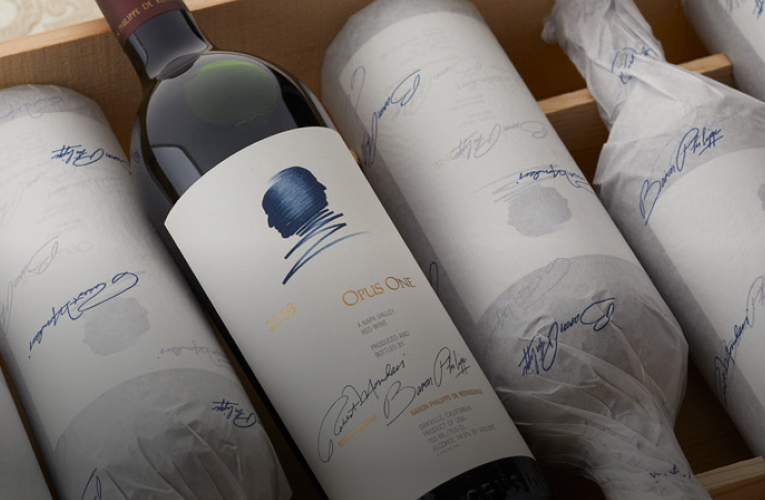
#Staff Column
2023.07.11
1 LIKE
1,166 VIEW
-
-
- 메일 공유
-
https://stories.amorepacific.com/en/a-tale-of-two-terroirs-old-world-versus-new-world-wines
A Tale of Two Terroirs: Old World versus New World Wines

Columnist | Introducing the columns written by member of Amorepacific Group
Wine 101
Part 2. A Tale of Two Terroirs: Old World versus New World Wines
Part 2. A Tale of Two Terroirs: Old World versus New World Wines

Columnist
KIM MINU
Innisfree GTM Team
Innisfree GTM Team
The roots of wine are deeply entrenched in Eastern Europe. The genesis of viticulture is traditionally attributed to the lands now known as Georgia and Armenia, dating back nearly 9,000 years. Over the centuries, this wine made its way into Arab territories
and is said to have been introduced to Egypt some 5,000 years ago. The historic beverage took a significant turn when it permeated into Italy and began to proliferate extensively, alongside the expansion of the Roman legions. During conflicts, wine
served as a vital substitute for potentially contaminated water. Rations that exceeded a liter per day were not unusual, and in protracted warfare, the Romans went as far as planting vineyards on-site for replenishment. In the lexicon of the wine industry,
there is common parlance that distinguishes wines as either Old World or New World. So, does this imply that Georgia, as the oldest viticultural region, is part of the Old World? Let's delve into this intriguing proposition.
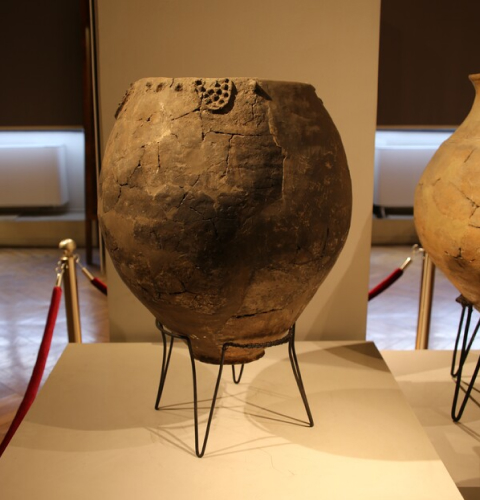 ▲Source: Sommelier Times
< Neolithic pottery at the National Museum of Georgia – believed to have been used for vinification. >
▲Source: Sommelier Times
< Neolithic pottery at the National Museum of Georgia – believed to have been used for vinification. >
Old World and New World Wines: If it Tastes Good,
It's the Original, Right?
In our modern times, the wine industry is experiencing an accelerated advancement. These progressions reflect not just an expansion in volume but also a surge in quality. These dual advancements are the collective outcome of efforts exerted by the Old
World and the New World to elevate the wine industry within their respective regions. Wines from the Old World refer specifically to those emanating from European nations such as France, Italy, and Spain. In contrast, the term ‘New World’ encompasses
wines produced in countries beyond Europe, including the United States, Chile, Argentina, Australia, New Zealand, and South Africa.
As earlier alluded to, the cradle of winemaking was not located in the well-known vinous powerhouses of the Old World such as France or Italy. Georgia, where archaeologists have unearthed Neolithic wine-aging pottery, furnishes evidence of wine production as far back as 8,000 years. Thus, in the strictest temporal sense, referring to European wines as ‘Old World’ might appear to be somewhat of a misnomer. However, given Europe's significant role in disseminating and championing wine across the globe over an extended period, it seems fitting to attribute the designations ‘originator’ or ‘Old World’ to this region. After all, numerous nations, once subservient to European rule, have since gained their sovereignty and emerged as proud wine producers in their own right.
As earlier alluded to, the cradle of winemaking was not located in the well-known vinous powerhouses of the Old World such as France or Italy. Georgia, where archaeologists have unearthed Neolithic wine-aging pottery, furnishes evidence of wine production as far back as 8,000 years. Thus, in the strictest temporal sense, referring to European wines as ‘Old World’ might appear to be somewhat of a misnomer. However, given Europe's significant role in disseminating and championing wine across the globe over an extended period, it seems fitting to attribute the designations ‘originator’ or ‘Old World’ to this region. After all, numerous nations, once subservient to European rule, have since gained their sovereignty and emerged as proud wine producers in their own right.
Unveiling the Signature Wines of Two Distinct Regions
With the demarcation between Old World and New World wines established, it's now time to dissect their distinct characteristics. To illuminate this effectively, we'll compare these classifications of wines to the contrasting ambiance of an enduring local
tavern, operated by a somewhat taciturn elderly man, versus a newly emerged, fashion-forward hotspot.
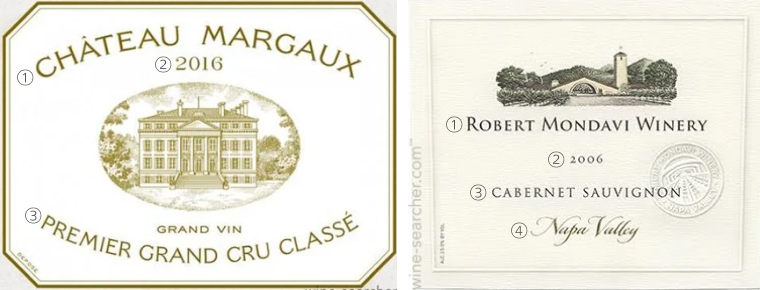 ▲Source : wine-searcher.com
< Old World/New World Wine Labels >
▲Source : wine-searcher.com
< Old World/New World Wine Labels >
The divergence is immediately apparent in the wine labels, which can be perceived as being the public face of the wineries. The eminent French wine, Château Margaux, as seen on the left, sequentially inscribed ① the producer, ② the vintage, and ③ the
wine grade on its label. Conversely, the American wine on the right reveals ① the producer, ② the vintage, ③ the grape variety, and ④ the region of production, hence offering supplementary details concerning the varietal and region. Employing an analogy,
Old World wines could be compared to a traditional tavern where the menu is non-existent, and the owner serves a pre-determined selection, whereas New World wines resonate with the ethos of an avant-garde restaurant that willingly discloses the ingredients
comprising the dish. Old World wines, including those from France, are bound by regional regulations to maintain their integrity, including specific grape varieties. A precise regional designation invariably hints at certain grape varieties, rendering
explicit notation superfluous. Wine connoisseurs who can deduce the grape merely by scrutinizing the label are indeed esteemed figures in my view.
New World wines, on the other hand, are often crafted with a more liberal philosophy. A multitude of varietals is nurtured within the same region, with relentless exploration and innovation at the helm. Producers who adapt to novel terrains by cultivating fitting grape varietals are judiciously indicating the region and grape varietals on their labels as a gesture of transparency.
New World wines, on the other hand, are often crafted with a more liberal philosophy. A multitude of varietals is nurtured within the same region, with relentless exploration and innovation at the helm. Producers who adapt to novel terrains by cultivating fitting grape varietals are judiciously indicating the region and grape varietals on their labels as a gesture of transparency.
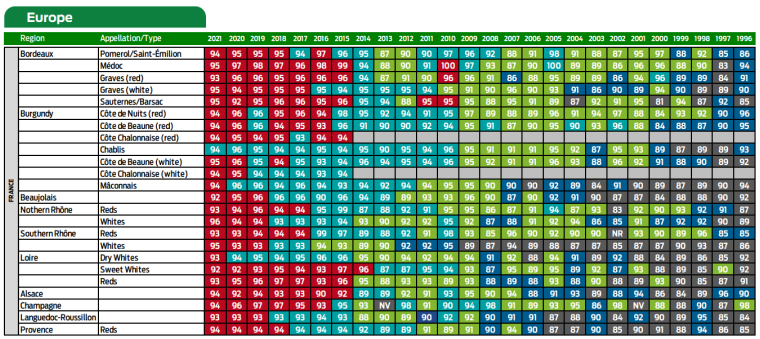 ▲Source : wine enthusiast
< French Wine Vintage Chart >
▲Source : wine enthusiast
< French Wine Vintage Chart >
Regardless of the continent, the vintage year is a constant feature on all wine labels. However, the interpretation of the vintage year holds varying significance across regions. Old World nations strictly supervise the production process via stringent
laws, thereby curtailing artificial interference. Measures such as the use of protective coverings during excessive rain to retain sugar levels and sprinkling water to sustain grape quality amid prolonged droughts are disallowed. This regulatory approach
inherently gives rise to variations in quality dependent on the vintage year, leading to the formulation of vintage charts, a scoring system distinguishing favorable from less favorable years. Conversely, New World wines permit a greater degree of intervention,
ensuring the production of high-quality wines even during less ideal years. However, it should be noted that this does not suggest an absolute reliance on the vintage chart for Old World wines. As agricultural technology progresses relentlessly, the
disparities induced by varying weather conditions are steadily diminishing. This consistent enhancement in wine production technology, ensuring the creation of exemplary wines regardless of the conditions, is indeed an evolution to be celebrated.
A Delicate Dance of Taste: The New World Versus Old World Wines
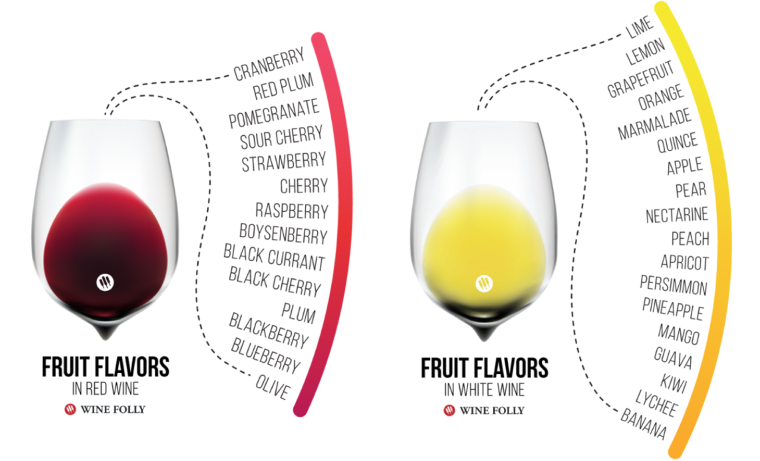 ▲Source: Wine folly
< Decoding the Aroma of Wines (Descending Into Warmer Climates) >
▲Source: Wine folly
< Decoding the Aroma of Wines (Descending Into Warmer Climates) >
Old World wines have evolved, underlining their unique regional characteristics, the artful harmony with gastronomic delights, and an inherent potential for graceful aging. These wines, crafted with an artisan's heart, nestle comfortably within the constraints
of the native land and its climate, boasting markedly distinct personalities representative of their geographical heritage. The unequivocal role of the Appellation d'Origine Contrôlée (AOC) system in conserving tradition and individuality is well-established,
as it governs origins with a judicious hand. As a matter of common knowledge, Old World wines typically exhibit a lower alcohol content, heightened acidity, and a dominant “mineral taste,” often overshadowing the “fruitiness.” This phenomenon owes its
existence to the ever-changing and cool European climate that greatly influences grape cultivation.
In contrast, the New World wines owe their evolution to the delicate interplay of environmental adaptation, regulation, and innovation. Establishing a winemaking process in the New World was far from easy. The esteemed European grape varietals did not flourish as anticipated in these unfamiliar soils, obliging winemakers to step in as “custodians of the environment.” This role mandated a scientific and intricate strategy, involving the measured supply of water via irrigation and the meticulous selection and cultivation of yeast strains. Reflecting on the climates of prominent New World territories, such as Chile, California, and Australia, the flavor profile of the wines becomes somewhat predictable. The high temperatures and generous sunlight elevate sugar levels, leading to a natural residual sweetness and a mature fruit jam-like essence during the alcohol fermentation process. These charming traits have an unmistakable appeal, particularly for novices. Moreover, the distinctly sweet and potent aroma from the oak barrels of the New World can notably sway preferences.
In contrast, the New World wines owe their evolution to the delicate interplay of environmental adaptation, regulation, and innovation. Establishing a winemaking process in the New World was far from easy. The esteemed European grape varietals did not flourish as anticipated in these unfamiliar soils, obliging winemakers to step in as “custodians of the environment.” This role mandated a scientific and intricate strategy, involving the measured supply of water via irrigation and the meticulous selection and cultivation of yeast strains. Reflecting on the climates of prominent New World territories, such as Chile, California, and Australia, the flavor profile of the wines becomes somewhat predictable. The high temperatures and generous sunlight elevate sugar levels, leading to a natural residual sweetness and a mature fruit jam-like essence during the alcohol fermentation process. These charming traits have an unmistakable appeal, particularly for novices. Moreover, the distinctly sweet and potent aroma from the oak barrels of the New World can notably sway preferences.
A Riveting Confrontation between the New World and Old World:
The Judgment of Paris
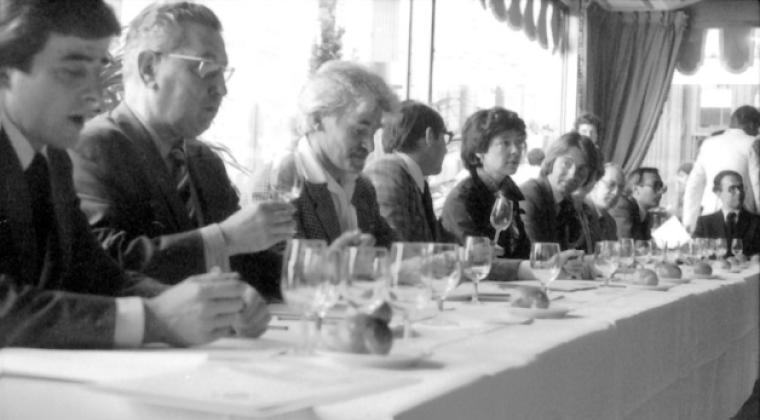 ▲Source: Google
< The Judgment of Paris >
▲Source: Google
< The Judgment of Paris >
The question of “Which continent's wines reign superior?” continues to spark passionate debates. In fact, there have been instances when the continents faced each other in high-stakes showdowns, with their pride at stake. The most renowned of these confrontations
is “The Judgment of Paris.” Back in 1976, an esteemed panel of eleven critics convened at the Paris Intercontinental Hotel to conduct a blind tasting of French and American wines. The panel predominantly consisted of French judges, with a lone representative
from both Britain and America. While it may initially seem partial, any concerns of biased judgment were alleviated due to the blind-tasting approach, which withheld information about the wines. Furthermore, given the French's formidable pride in their
wines, they staunchly believed that wines originating from rural America would hardly be a worthy adversary to their illustrious French counterparts.
The outcome was nothing short of startling. Both the white and red wines from the United States clinched the top honors. Intriguingly, the tasting of the red wines was conducted after the announcement of the white wine results. Following the revelation of the white wine scores, the resilient French wine connoisseurs naturally rallied with the conviction that ‘an American wine cannot possibly secure the top spot this time.’ However, much to their astonishment, the United States seized first place in the red wine category as well.
The outcome was nothing short of startling. Both the white and red wines from the United States clinched the top honors. Intriguingly, the tasting of the red wines was conducted after the announcement of the white wine results. Following the revelation of the white wine scores, the resilient French wine connoisseurs naturally rallied with the conviction that ‘an American wine cannot possibly secure the top spot this time.’ However, much to their astonishment, the United States seized first place in the red wine category as well.
 < Outcome of the Judgment of Paris – Left: White Wine / Right: Red Wine >
< Outcome of the Judgment of Paris – Left: White Wine / Right: Red Wine >
The wine sector was plunged into a state of disbelief. It would not be an exaggeration to compare this astonishment to a youth soccer squad triumphing over a national team. The progress of American wine could have been warmly welcomed. Nevertheless,
dissenting voices arose among the judges who challenged the revolutionary verdict. The judges were inevitably confronted with allegations of betrayal. France attempted to minimize the significance of this occurrence in its news broadcasts, yet the episode
received extensive coverage in other countries. Intriguingly, it was the Italians — locked in a passionate battle with France for the mantle of wine originator — who reputedly reveled the most in this unexpected turn of events.
Three decades later, in 2006, following the argument that “French wines are designed for long-term maturation, and if compared at this juncture, France would emerge victorious,” a rematch was organized using the same wines. The outcome? American wines once again demonstrated their merit by sweeping the top five positions, reasserting their dominance on a global stage.
Three decades later, in 2006, following the argument that “French wines are designed for long-term maturation, and if compared at this juncture, France would emerge victorious,” a rematch was organized using the same wines. The outcome? American wines once again demonstrated their merit by sweeping the top five positions, reasserting their dominance on a global stage.
The Pinnacle of Continental Collaboration: Opus One
Although the Judgment of Paris concluded with a victory for the United States, it by no means implies a deficiency in the quality of Old World wines. More accurately, it confirmed the proposition that, with the right combination of advantageous environmental
conditions, progressively evolving winemaking techniques, and ample investment, any country could cultivate exceptional wines. These producers who represent each continent weren't always on conflicting paths. Are you acquainted with luxury wine, a result
of the collaboration between the crests of Old World and New World producers? This renowned brand goes by the name “Opus One.”
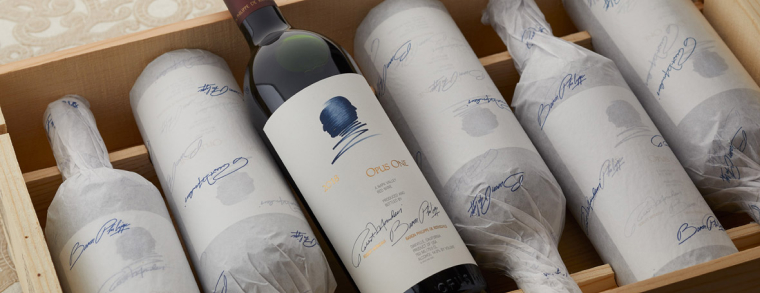 ▲Source: Google
< OPUS ONE 2018 >
▲Source: Google
< OPUS ONE 2018 >
The phrase “Opus One,” a terminology borrowed from music, denotes ‘composition number one.’ This suggests a metaphorical equivalence where “a bottle of wine stands as a symphony, and a glass carries the tune of a melody.” This distinguished Bordeaux-style
wine was conceived in 1979, a magnificent fusion between Château Mouton Rothschild, widely acknowledged as one of the ‘five first growths’ of France's illustrious Bordeaux region, and the legendary Robert Mondavi, a seminal figure in American viticulture.
The portraits and autographs adorning the label belong to none other than Robert Mondavi and Baron Philippe de Rothschild themselves. Intriguingly, it's worth noting that Château Mouton Rothschild's red wine just missed the top spot, securing second
place in the Judgment of Paris. One can't help but admire the audacious elegance of the possibly indignant Old World maestro extending a gracious hand to America.
With the convergence of the finest winemaking prowess from both continents, the ambition to craft Napa Valley's finest wine was a foregone conclusion. Being a collaboration between two of the most iconic brands across the continents, the symbolic union of ‘classic European winemaking techniques’ and ‘contemporary American viniculture’ captivated observers. The 1979 vintage broke records, reaching a staggering $24,000 per case at auction, setting a new high for California wines of the era. Even OVERTURE, their second-tier wine, commands a price of about $200. The fascinating story of this transcontinental fusion, indeed, could have added to its acclaim as a prestigious token for celebrating promotions or corporate mergers.
With the convergence of the finest winemaking prowess from both continents, the ambition to craft Napa Valley's finest wine was a foregone conclusion. Being a collaboration between two of the most iconic brands across the continents, the symbolic union of ‘classic European winemaking techniques’ and ‘contemporary American viniculture’ captivated observers. The 1979 vintage broke records, reaching a staggering $24,000 per case at auction, setting a new high for California wines of the era. Even OVERTURE, their second-tier wine, commands a price of about $200. The fascinating story of this transcontinental fusion, indeed, could have added to its acclaim as a prestigious token for celebrating promotions or corporate mergers.
Wine Defies Absolute Dictate
We've made a comparison between New World and Old World wines in this discussion. Despite our explanation, there are countless small differences between the wines of these two hemispheres. However, it is not imperative to agonize over your selection.
The world of wine is far from ‘absolute.’ For instance, New Zealand, although belonging to the New World, leverages its cool climate to masterfully produce wines characterized by a refreshing and high acidity profile. Additionally, certain regions in
Chile, lauded as the Bordeaux of the New World, have a knack for creating splendid Old World-style wines. The duality of preserving tradition and simultaneously fostering new trends, coupled with the vast array of winemaking styles, all find representation
in a single bottle of wine. Consequently, we firmly believe that the audacity to explore new wines outweighs all else. Why not indulge in a comparative tasting of an Old World and New World wine from the same varietal today? I guarantee it would be
an enlightening encounter. Here, we draw the curtain on our second column.
-
Like
1 -
Recommend
0 -
Thumbs up
0 -
Supporting
0 -
Want follow-up article
0


